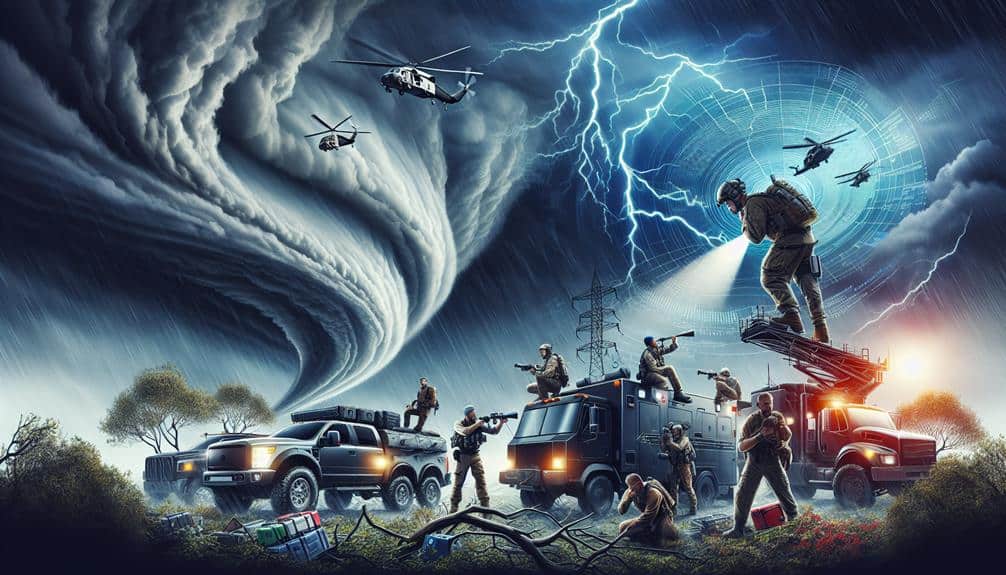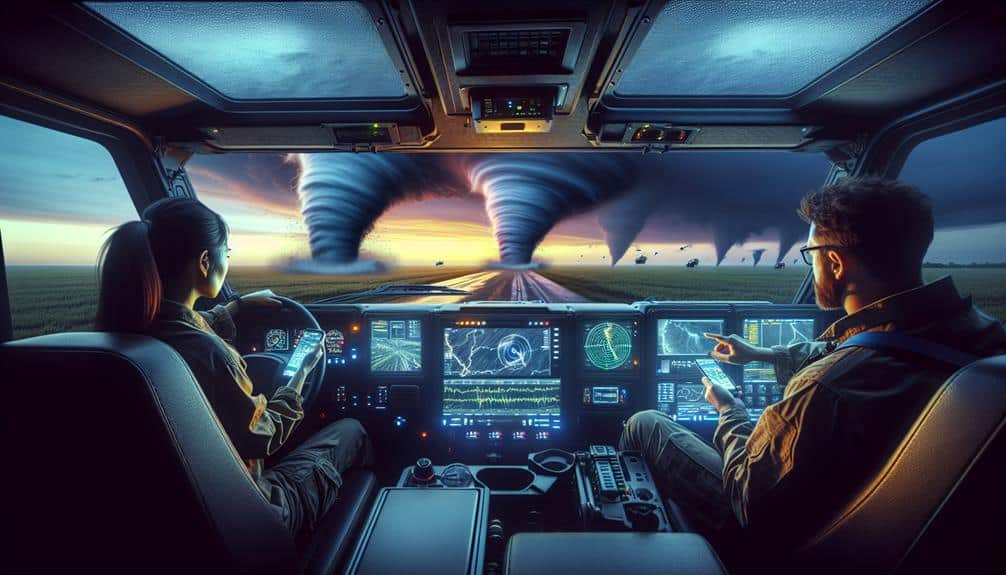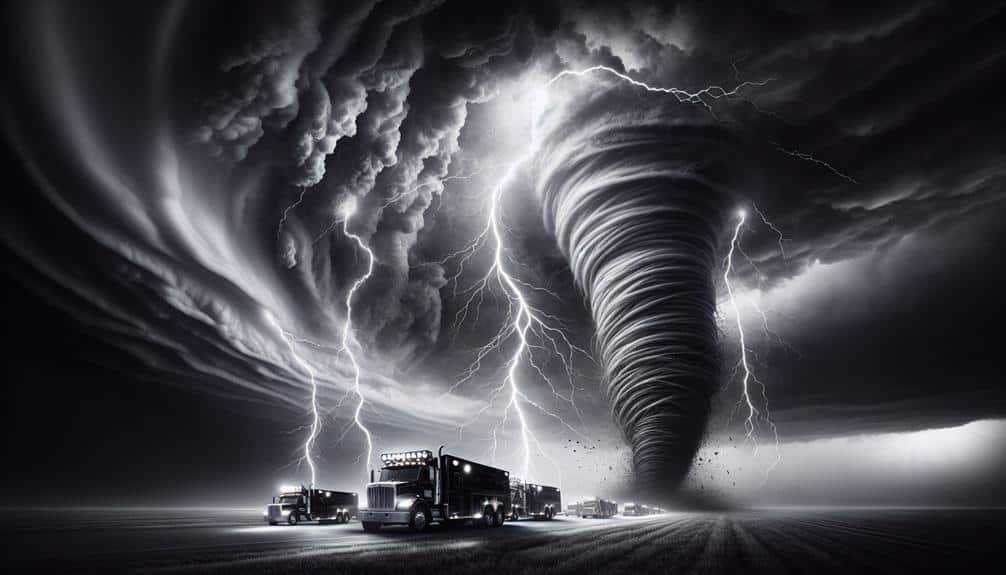We rely on real-time storm tracking to enhance our safety measures and optimize our chase routes. Advanced data models and algorithms improve forecast accuracy, while machine learning and real-time data access allow swift, informed decision-making. This helps us to dynamically adjust our strategies, minimizing risks and maximizing efficiency. By sharing critical updates and collaborating with local authorities, we increase our situational awareness and response efficacy. These measures reduce response times and support robust research efforts, always keeping us one step ahead of the storm. You'll explore further the intricate details that make these methods indispensable.
Key Points
- Enhances safety by providing critical updates for on-the-spot decision-making.
- Improves forecast accuracy with high-resolution data and predictive models.
- Optimizes chase routes through real-time data and dynamic rerouting.
- Facilitates coordinated response efforts and efficient resource allocation.
Enhancing Safety Measures
Implementing advanced real-time storm tracking systems significantly enhances our ability to enforce safety measures for storm chasers. By integrating these systems, we can establish robust safety protocols that guarantee chasers are well-informed and protected. Real-time data allows us to predict storm paths with high precision, enabling us to create dynamic safety guidelines that adapt to rapidly changing conditions. This proactive approach minimizes risk and maximizes safety.
Furthermore, these systems enhance our communication strategies. Instantaneous data transmission means we can relay critical updates to storm chasers in real-time. This immediate communication is crucial for making swift decisions, such as redirecting routes or issuing evacuation orders. For instance, if a tornado's trajectory shifts unexpectedly, our real-time alerts make sure chasers are promptly informed, reducing the likelihood of them being caught in dangerous situations.
The combination of precise tracking and rapid communication empowers us to maintain a balance between the thrill of the chase and necessary safety measures. Data-driven insights allow us to fine-tune our strategies continually, ensuring that we provide the best possible guidance. Ultimately, these advancements enable us to pursue our passion for storm chasing with greater freedom and security.
Improving Forecast Accuracy
Improving forecast accuracy hinges on utilizing high-resolution data models and sophisticated algorithms to predict storm behavior with greater precision. By integrating real-time data streams, we can enhance our predictive analytics, enabling us to anticipate storm patterns with exceptional accuracy. This approach not only harnesses vast amounts of historical and real-time data but also utilizes machine learning techniques to continuously enhance our forecasting models.
Data visualization plays a pivotal role in this process, transforming complex data sets into intuitive, actionable insights. High-resolution visualizations allow us to interpret the evolving dynamics of a storm system rapidly. We can evaluate wind speeds, pressure changes, and temperature variations at a glance, facilitating the forecasting of the storm's trajectory and intensity.
Our objective is to use these advanced tools to stay one step ahead of the storm, ensuring we make informed decisions based on the most precise data available. Predictive analytics, empowered by these high-resolution models, provides us the flexibility to track storms more safely and effectively.
Optimizing Chase Routes
By leveraging our improved forecasting capabilities, we can now focus on optimizing chase routes to ensure we're positioned at the most strategic locations for real-time data collection and safety. Real-time tracking and accurate storm prediction are crucial for fine-tuning our movements. Utilizing cutting-edge meteorological tools, we can analyze evolving weather patterns and dynamically adjust our routes. This approach minimizes risks while maximizing data acquisition efficiency.
Route optimization hinges on integrating real-time data with predictive models. By continuously monitoring storm trajectories and intensities, we can make informed decisions about our pathways. This guarantees we don't waste time on less promising areas and can quickly reroute as conditions change. For instance, high-resolution radar and satellite data allow us to pinpoint the most active parts of a storm, directing us to the core areas of interest.
Our ability to adapt on the fly enhances our freedom to explore and document storms comprehensively. It's not just about being in the right place at the right time; it's about maintaining the agility to adjust our strategy as new information becomes available. This methodology keeps us one step ahead, turning storm chasing into a calculated and efficient endeavor.
Real-Time Data Access
To optimize our storm chasing efforts, we rely on immediate weather updates which enhance our decision-making accuracy.
Real-time data access is essential for implementing enhanced safety measures, reducing our exposure to hazardous conditions.
Immediate Weather Updates
Real-time data access empowers storm chasers with precise and immediate weather updates, essential for making informed decisions during severe weather events. By leveraging advanced mobile apps and robust communication networks, we can receive continuous weather alerts that inform us of changing conditions. This capability is vital for our emergency response strategies, enabling us to act swiftly and efficiently.
Having immediate access to weather data offers several key advantages:
- Timely Weather Alerts: Mobile apps provide instant notifications about storm developments, ensuring we're always aware of potential threats. This allows us to position ourselves effectively and avoid hazardous areas.
- Enhanced Emergency Response: Real-time updates facilitate better coordination with local authorities and emergency services. By staying informed, we can relay important information about storm paths and intensities, aiding in broader community safety efforts.
- Dynamic Decision-Making: Access to the latest weather data allows us to make real-time adjustments to our chase plans. This flexibility is essential for avoiding dangerous situations and maximizing our ability to collect valuable data.
Enhanced Safety Measures
Leveraging real-time data access greatly enhances our safety measures by providing critical insights into storm trajectories and potential hazards. This real-time information empowers us to make informed decisions quickly, reducing the risks associated with storm chasing.
For instance, integrating GPS-based tracking with up-to-the-minute radar imagery allows us to pinpoint our location relative to severe weather systems accurately.
Emergency alerts play a pivotal role in our safety strategy. These alerts, derived from real-time data, enable us to receive immediate notifications about tornadoes, flash floods, and other imminent threats. By synchronizing these alerts with our communication protocols, we guarantee every team member is aware of the developing situation, allowing us to coordinate our movements effectively.
Our communication protocols are also significantly bolstered by real-time data. By maintaining a constant flow of information through satellite phones, radios, and mobile apps, we can disseminate critical updates instantaneously. This continuous communication loop not only keeps us updated on storm developments but also enhances our ability to respond to sudden changes in weather conditions.
In essence, real-time data access transforms our approach to storm chasing, offering a robust framework for enhanced safety measures. This secures we can pursue our passion for storm chasing while minimizing potential dangers.
Community Collaboration

We can enhance our storm tracking accuracy by sharing critical updates in real-time, ensuring that all team members have the latest data.
Coordinated response efforts allow us to allocate resources more efficiently, minimizing redundancy.
Sharing Critical Updates
Consistently exchanging real-time data and observations among storm chasers enhances predictive accuracy and safety for all involved. By fostering community engagement and leveraging advanced technology integration, we can improve our understanding of storm dynamics. The collaborative approach ensures that we pool our collective resources, which is essential for accurate storm predictions and timely warnings.
Real-time updates enable us to react promptly to evolving weather conditions, optimizing our decision-making processes. The immediacy of these updates is invaluable, enabling us to make quick adjustments to our strategies.
Here's how sharing critical updates benefits us:
- Enhanced Predictive Models: By integrating data from multiple sources, we create a more detailed and precise model of storm behavior.
- Increased Safety: Real-time information allows us to avoid hazardous areas, reducing the risks associated with storm chasing.
- Resource Optimization: Sharing updates helps allocate resources more efficiently, making sure we're not duplicating efforts or missing important data points.
In this data-driven, analytical approach, the fusion of community engagement and technology integration empowers us to maximize our storm-chasing endeavors. The collaborative nature of real-time storm tracking not only enriches individual experiences but also drives our collective mission forward.
Coordinated Response Efforts
Building on the foundation of real-time updates, coordinated response efforts through community collaboration enable us to systematically address the complexities of storm chasing. By leveraging emergency coordination and disaster management protocols, we enhance our capacity to anticipate and respond to volatile weather conditions.
Rapid communication is key. It empowers us to share critical data instantaneously, facilitating informed decision-making. This is crucial for implementing effective response strategies that protect both storm chasers and local communities.
Our network of storm chasers operates as a decentralized unit, yet remains interconnected through sophisticated communication channels. These channels support real-time data exchange, which is essential for emergency coordination.
When we're aware of the exact location and intensity of a storm, we can deploy response strategies that minimize risk and maximize efficiency. For instance, we can reroute chasers away from danger zones or mobilize resources to areas more likely to be affected.
We rely on a combination of technological tools and human expertise to fine-tune our disaster management approach. This guarantees that we're not just reacting to storms but actively managing the risks involved.
Resource Pooling Strategies
Pooling resources via community collaboration significantly enhances our ability to manage storm chasing operations with greater efficiency and effectiveness. By leveraging collaborative planning and data sharing, we can streamline our efforts and maximize our impact.
Real-time data exchange among storm chasers allows us to make informed decisions rapidly, reducing redundant efforts and maximizing resource allocation.
Here's how we can achieve this:
- Centralized Data Sharing Platforms: By utilizing cloud-based systems, we can aggregate and distribute real-time storm data to all participants. This guarantees everyone has access to the latest information, enhancing situational awareness and decision-making processes.
- Collaborative Planning Initiatives: Through joint planning meetings and strategy sessions, we can coordinate our activities and assign roles based on individual strengths and available resources. This not only increases operational efficiency but also enhances safety, as each team knows the others' locations and objectives.
- Resource Allocation Algorithms: Implementing algorithms to allocate resources dynamically based on real-time data and predictive models can ensure efficient deployment of equipment and personnel. This data-driven approach minimizes downtime and maximizes our field effectiveness.
Reducing Response Time
Reducing response time in storm tracking requires leveraging advanced algorithms and real-time data analytics to enhance decision-making precision for storm chasers. By integrating machine learning models with vast datasets, we can achieve unprecedented response efficiency. These algorithms process meteorological data in real-time, allowing us to predict storm trajectories and intensities with greater accuracy. This precision is essential for maximizing emergency preparedness, enabling us to deploy resources and personnel more effectively.
Our goal is clear: minimize the time between storm detection and action. With real-time analytics, we can identify potential threats faster and issue warnings sooner. This immediacy is crucial for safeguarding communities and reducing the risk of property damage and loss of life. High-frequency data inputs from satellites, radar, and IoT sensors feed into our systems, continuously refining our predictions and improving our response strategies.
Moreover, advanced visualization tools and GIS mapping enhance our situational awareness, providing a thorough view of storm developments. These tools allow us to make informed decisions quickly, bypassing the delays inherent in traditional methods.
Advancing Research Efforts

By continually investing in cutting-edge meteorological research, we can enhance our storm prediction models and refine our real-time tracking capabilities. This investment allows us to utilize advanced data analysis techniques and integrate state-of-the-art technology, leading to more accurate forecasts and timelier updates.
Firstly, integrating high-resolution satellite data provides us with more detailed insights into storm development. This allows us to:
- Enhance Predictive Accuracy: Improved data analysis helps us forecast storm paths and intensities with greater precision.
- Optimize Resource Allocation: Better predictions guarantee that resources are deployed efficiently, minimizing waste and maximizing effectiveness.
- Boost Safety Measures: Accurate tracking reduces uncertainty, enabling quicker, safer decisions for storm chasers on the ground.
Secondly, real-time technology integration, such as machine learning algorithms, enables us to process vast amounts of meteorological data more swiftly. This rapid processing translates to quicker updates, keeping us informed and ahead of the storm.
Lastly, collaborative efforts with research institutions and government agencies enrich our data pool and technological toolbox. This collaboration fosters innovation and guarantees we remain at the forefront of meteorological advancements.
Frequently Asked Questions
What Equipment Do Storm Chasers Use for Real-Time Tracking?
We rely on cutting-edge GPS technology and radar systems to navigate storms with pinpoint accuracy. Satellite imagery and robust communication devices guarantee we stay one step ahead, making the difference between life and death.
How Do Storm Chasers Communicate During a Chase?
We use multiple communication methods like radios, cell phones, and GPS to maintain constant contact. Adhering to safety protocols, we share real-time data and location updates, guaranteeing everyone's safety while maximizing the freedom to pursue storm tracking.
What Training Is Required to Become a Storm Chaser?
Mastering safety precautions and acquiring meteorology expertise is essential to successfully handle the storm's fury. We delve into data analysis, study weather patterns, and undergo rigorous training to make sure we're prepared for the unpredictable dance with nature's most powerful forces.
How Do Storm Chasers Fund Their Expeditions?
We rely on diverse funding sources, including sponsors and crowdfunding, to finance our expeditions. Financial challenges persist, but strategic planning and leveraging endorsements help us overcome obstacles, ensuring we can chase storms while maintaining our operational freedom.
What Are the Legal Considerations for Storm Chasing?
We must consider liability risks and make sure our insurance coverage is thorough. Analyzing local regulations and obtaining necessary permits is important. Data shows insufficient coverage can result in significant financial loss and legal consequences during storm chasing activities.
